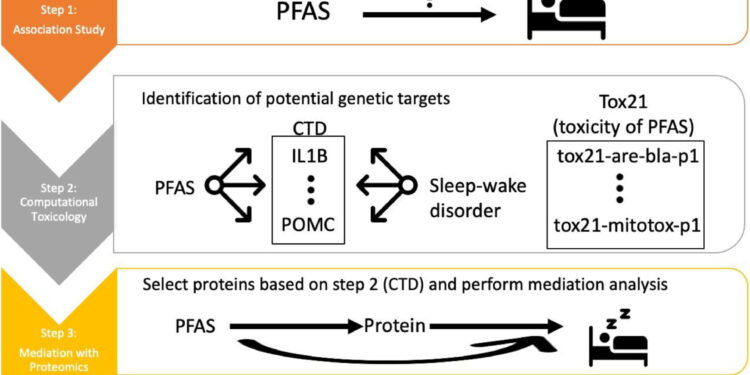Analytical workflow. Credit: Environmental advances (2024). DOI: 10.1016/j.envadv.2024.100585
Research from the Keck School of Medicine of USC has shown that levels of “forever chemicals” in the blood are linked to disruptions in a fundamental pillar of health: sleep.
In the first study to examine this relationship in young adults, participants with higher levels of four specific types of per- and polyfluoroalkyl substances (PFAS) in their blood experienced poorer sleep. Scientists are the first to look at the underlying molecular mechanisms, identifying genes involved in the body’s natural defenses and a hormone that regulates sleep.
PFAS enter the body through contact with consumer products and are even ingested with food and water. They do not break down easily and can persist in the environment for decades. The vast majority of Americans have detectable levels of PFAS in their blood.
In recent years, perennial chemicals have been linked to adverse health effects, ranging from cancer and neurological diseases to hormonal and immune deficiencies. The study, supported by the National Institutes of Health (NIH) and published in the journal Environmental advancesis part of a small body of research regarding PFAS and sleep.
“Because the body needs sleep every day, if PFAS can interfere with your sleep, it may affect you more immediately than other chronic health conditions,” said first corresponding author Shiwen (Sherlock) Li, Ph.D., postdoctoral researcher. in the Department of Population and Public Health Sciences at the Keck School of Medicine.
“In the long term, poor sleep has been linked to outcomes such as neurological and behavioral problems, type 2 diabetes, and Alzheimer’s disease.”
In addition to providing insight into the biology of PFAS’s influence on sleep, the study could add to evidence suggesting a rationale for stricter regulation of permanent chemicals.
“Sleep quality is an issue that affects almost everyone, so the impact of PFAS on sleep may have policy implications,” said Li, advised by study co-authors Lida Chatzi, MD, Ph.D., director of the USC Center. for Translational Environmental Health Research and professor of public and population health sciences and pediatrics, and Max Aung, Ph.D., MPH, associate director of the center’s community engagement and assistant professor of health sciences. public and population health.
Identifying eternal chemicals potentially detrimental to good sleep
Researchers collected blood samples and sleep information from 144 participants, ages 19 to 24, who were part of the USC Children’s Health Study. Two sets of measurements were taken years apart, with about half of the participants contributing to both.
Of seven types of PFAS examined, four were significantly associated with reduced sleep or poorer sleep quality: PFDA, PFHxS, PFOA, and PFOS.
For the first three of these, young adults with blood levels in the highest third sleep on average about 80 minutes less per night than those in the lowest third. High combined levels of PFAS are also correlated with shorter sleep. For PFOS, elevated blood concentrations were significantly related to self-reported problems falling asleep, staying asleep, waking up, or feeling tired during waking hours.
The four perennial chemicals, some of which are associated with cancer and neurological disorders ranging from ADHD to Alzheimer’s disease, are considered “legacy PFAS.” Although they were widely used in the 1950s through the early 2000s, they have since been largely abandoned in favor of similar compounds with unknown safety profiles.
“It could be a matter of cumulative exposure over time,” Li said. “What we measured in the blood is probably due to exposure since birth, or even prenatal exposures.”
Biological clues emerge about PFAS and sleep disruption
The team analyzed the four types of PFAS using toxicology databases that compile research linking chemicals, diseases and changes in gene expression. Since no previous research has brought together PFAS, sleep, and gene expression, the team looked at the overlap between genes affected by the four perennial chemicals and genes linked to sleep disorders.
The investigators then profiled a panel of proteins – the products of the blueprints written in genes – from participants’ blood samples. Of more than 600 candidate genes, seven activated by PFAS appeared to influence sleep.
One important factor was an immune-related gene called HSD11B1. It helps produce the hormone cortisol, which plays an important role in regulating the rhythm of sleep and wakefulness.
“If expression of the protein encoded by HSD11B1 is disrupted, that means cortisol levels could also be disrupted,” Li said. “This in turn affects sleep.”
Another gene apparently important in the impact of PFAS on sleep, cathepsin B, is linked to cognitive function and memory. The resulting enzyme is a precursor to beta-amyloid proteins, found in plaques in the brains of Alzheimer’s patients. High levels of this enzyme have been linked to cognitive decline in Alzheimer’s disease, which has its own links to sleep deficits.
Investigators will continue to explore children’s sleep chemicals and patterns forever as part of the NIH’s Multi-Omics Consortium for Health and Disease. They are also continuing laboratory studies of the genes identified in the study and the associations between PFOS and brain development.
More information:
Shiwen Li et al, Per- and polyfluoroalkyl substances and sleep disorders: mediating roles of proteins, Environmental advances (2024). DOI: 10.1016/j.envadv.2024.100585
Provided by the Keck School of Medicine of USC
Quote: Exposure to PFAS linked to sleep disturbances in young adults (October 4, 2024) retrieved October 4, 2024 from
This document is subject to copyright. Except for fair use for private study or research purposes, no part may be reproduced without written permission. The content is provided for informational purposes only.



